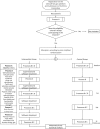Protocol for evaluating the effects of a foot-ankle therapeutic exercise program on daily activity, foot-ankle functionality, and biomechanics in people with diabetic polyneuropathy: a randomized controlled trial
- PMID: 30428863
- PMCID: PMC6236874
- DOI: 10.1186/s12891-018-2323-0
Protocol for evaluating the effects of a foot-ankle therapeutic exercise program on daily activity, foot-ankle functionality, and biomechanics in people with diabetic polyneuropathy: a randomized controlled trial
Abstract
Background: Diabetic polyneuropathy (DPN) negatively affects foot and ankle function (strength and flexibility), which itself affects the daily physical activity and quality of life of patients. A physical therapy protocol aiming to strengthen the intrinsic and extrinsic foot muscles and increase flexibility may be a promising approach to improve lower-extremity function, prevent further complications, and improve autonomy for daily living activities in these patients. Thus, the inclusion of a specific foot-related exercises focused on the main musculoskeletal impairments may have additional effects to the conventional interventions in the diabetic foot.
Methods/design: A prospective, parallel-group, outcome-assessor blinded, randomized controlled trial (RCT) will be conducted in 77 patients with DPN who will be randomly allocated to usual care (control arm) or usual care with supervised foot-ankle exercises aiming to increase strengh and flexibility twice a week for 12 weeks and remotely supervised foot-ankle exercises for a year through a web software. Patients will be evaluated 5 times in a 1 year period regarding daily physical activity level, self-selected and fast gait speeds (primary outcomes), foot ulcer incidence, ulcer risk classification, neuropathy testing, passive ankle range of motion, quality of life, foot health and functionality, foot muscle strength, plantar pressure, and foot-ankle kinematics and kinetics during gait.
Discussion: This study aims to assess the effect of a foot-ankle strength and flexibility program on a wide range of musculoskeletal, activity-related, biomechanical, and clinical outcomes in DPN patients. We intend to demonstrate evidence that the year-long training program is effective in increasing gait speed and daily physical activity level and in improving quality of life; foot strength, functionality, and mobility; and biomechanics while walking. The results will be published as soon as they are available.
Trial registration: This study has been registered at ClinicalTrials.gov as NCT02790931 (June 6, 2016) under the name "Effects of foot muscle strengthening in daily activity in diabetic neuropathic patients".
Keywords: Clinical trial; Diabetic foot; Diabetic neuropathies; Exercise; Foot ulcer; Physical therapy.
Conflict of interest statement
Ethics approval and consent to participate
This trial was approved by the Ethics Committee of the School of Medicine of the University of São Paulo (Protocol 1.464.870). All patients will be asked for written informed consent according to the standard forms and the researcher will obtain them.
Consent for publication
Written informed consent for publication of all images was obtained from the models.
Competing interests
The authors declare that they have no competing interests.
Publisher’s Note
Springer Nature remains neutral with regard to jurisdictional claims in published maps and institutional affiliations.
Figures
Similar articles
-
Effect of an educational booklet for prevention and treatment of foot musculoskeletal dysfunctions in people with diabetic neuropathy: the FOotCAre (FOCA) trial II, a study protocol of a randomized controlled trial.Trials. 2020 Feb 13;21(1):180. doi: 10.1186/s13063-020-4115-8. Trials. 2020. PMID: 32054510 Free PMC article.
-
Effectiveness of a web-based foot-ankle exercise program for treating ulcer risk factors in diabetic neuropathy in a randomized controlled trial.Sci Rep. 2024 Nov 8;14(1):27291. doi: 10.1038/s41598-024-78188-7. Sci Rep. 2024. PMID: 39516524 Free PMC article. Clinical Trial.
-
Study protocol for a randomized controlled trial on the effect of the Diabetic Foot Guidance System (SOPeD) for the prevention and treatment of foot musculoskeletal dysfunctions in people with diabetic neuropathy: the FOotCAre (FOCA) trial I.Trials. 2020 Jan 13;21(1):73. doi: 10.1186/s13063-019-4017-9. Trials. 2020. PMID: 31931855 Free PMC article.
-
The Effects of Ankle and Foot Exercises on Ankle Strength, Balance, and Falls in Older People: A Systematic Review and Meta-Analysis.Phys Ther. 2025 Jan 8;105(1):pzae157. doi: 10.1093/ptj/pzae157. Phys Ther. 2025. PMID: 39657220
-
Muscle Strengthening Exercises for the Foot and Ankle: A Scoping Review Exploring Adherence to Best Practice for Optimizing Musculoskeletal Health.J Foot Ankle Res. 2025 Jun;18(2):e70040. doi: 10.1002/jfa2.70040. J Foot Ankle Res. 2025. PMID: 40178827 Free PMC article.
Cited by
-
Traceable Features of Static Plantar Pressure Characteristics and Foot Postures in College Students with Hemiplegic Cerebral Palsy.J Pers Med. 2022 Mar 4;12(3):394. doi: 10.3390/jpm12030394. J Pers Med. 2022. PMID: 35330394 Free PMC article.
-
Foot-ankle therapeutic exercise program can improve gait speed in people with diabetic neuropathy: a randomized controlled trial.Sci Rep. 2022 May 9;12(1):7561. doi: 10.1038/s41598-022-11745-0. Sci Rep. 2022. PMID: 35534614 Free PMC article. Clinical Trial.
-
Severity of Neuropathy-Related Disability and Associated Factors of Diabetic Peripheral Neuropathy in a Tertiary Healthcare Center: A Comparative Cross-Sectional Study.Cureus. 2024 Mar 5;16(3):e55568. doi: 10.7759/cureus.55568. eCollection 2024 Mar. Cureus. 2024. PMID: 38576639 Free PMC article.
-
Effects of foot-ankle exercises on foot-ankle kinematics, plantar pressure, and gait kinetics in people with diabetic neuropathy: Secondary outcomes from a randomized controlled trial.Braz J Phys Ther. 2023 May-Jun;27(3):100517. doi: 10.1016/j.bjpt.2023.100517. Epub 2023 Jun 12. Braz J Phys Ther. 2023. PMID: 37348358 Free PMC article. Clinical Trial.
-
Feasibility and Preliminary Efficacy of a Foot-Ankle Exercise Program Aiming to Improve Foot-Ankle Functionality and Gait Biomechanics in People with Diabetic Neuropathy: A Randomized Controlled Trial.Sensors (Basel). 2020 Sep 9;20(18):5129. doi: 10.3390/s20185129. Sensors (Basel). 2020. PMID: 32916792 Free PMC article. Clinical Trial.
References
-
- Sartor CD, Hasue RH, Cacciari LP, et al. BMC Musculoskelet Disord. Rome: Physical therapy, speech and occupational therapy Dept, School of Medicine, University of São Paulo, 51, Cidade Universitária, São Paulo, SP, BrazilDepartment of technology and health, Italian National Institute of health; 2014. Effects of strengthening, stretching and functional training on foot function in patients with diabetic neuropathy: results of a randomized controlled trial; p. 137. - PMC - PubMed
Publication types
MeSH terms
Associated data
Grants and funding
LinkOut - more resources
Full Text Sources
Medical



